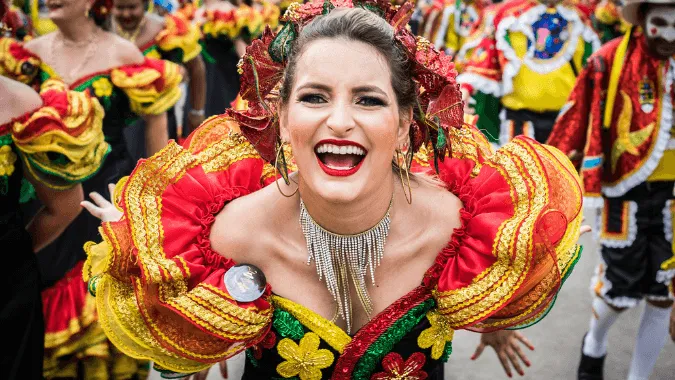Rio de Janeiro
![Essential Guide to Rio de Janeiro Carnival]()
![]()
![]()
Essential Guide to Rio de Janeiro Carnival
Tags:
1. HISTORY

Carnival became the main attraction of the modern city of Rio de Janeiro / Photo: Daytours4u
Traditionally, Carnival (Carnaval in Portuguese) was celebrated once a year before the Roman Catholic ritual Lent, a period in the Holy calendar where Catholics are required to fast and abstain from red meat and all earthly pleasures for 40 days before Holy week and Easter. The Carnaval festival was the final blow-out before the following fast. In fact, the name Carnaval itself derives from the Latin words "Carne vale" meaning “farewell meat”. During the 1400’s, Italy was renowned for its annual Carnival celebrations involving elaborate masquerade balls with extravagant costumes and soon other European Catholic countries such as France and Spain were following their example. Carnival celebrations spread to Brazil with the European colonisers and in 1723 the first Rio Carnival was held As the years went by, the Rio’s Carnival became an occasion for everyone, and transformed itself into the popular street party, where the inhabitants of Rio would wear colourful costumes and perform in competitive parades that were accompanied by an orchestra of strings, drums and other instruments, an event, which was soon to become the main attraction of the modern Carnival in Rio de Janeiro. The dates for today’s Brazilian Carnival still depend on the annual Catholic Calendar, falling on the days leading up to Lent, usually at the end of February or during March, officially starting on Saturday and finishing on Shrove Tuesday to begin Lent on Ash Wednesday. This year will be the exception! In 2022, the celebration will be held the last week of April, the week of April 20-30. Rio’s Carnival traditions have grown far beyond their original foundations by incorporating vibrant elements of Native American and African cultures, both expressing their Creole background and providing entertainment for people around the world whilst giving them an opportunity to learn about the true culture of Brazil and the soul of the Brazilians.2. SAMBA SCHOOLS & THE SAMBADROME

Samba schools parade from one end of the Rio Sambodrome to the other under the watchful eye of judges and 90,000 spectators / Photo: Daytours4u
Samba is at the heart of Rio and its Carnival and is incorporated into every aspect of the dancing and music. Its irresistible percussion beats and rhythms have the power to force even the most un-rhythmic and left-footed person into a frenzy of singing and dancing. Since its first appearance during Rio’s Carnivals in the 1920’s, Samba, along with the Samba Schools, have become the most essential part of the celebrations. All year round you can experience the invigorating atmosphere of Carnival Samba in Rio in venues such as Plataforma Samba or Rio Scenarium, however nothing comes close to the exciting atmosphere of Rio’s samba parades you’ll discover during Carnival especially at Rio’s iconic Sambadrome! The enormous purpose-built samba parade stadium, the Sambadrome, comes alive every year during Rio’s Carnival week when local samba schools parade competitively along the 700m stretch of runway dressed in sensational costumes alongside the spectacular parade floats, designed and built throughout the year with meticulous attention to detail. The competition is a magical feast for the eyes and ears, showcasing samba routines from 9 in the evening until sunrise and attracting many thousands of cheering fans, both tourists and local Brazilians dressed in the colours of their favorite Rio samba school. A samba school can either be an actual school or a communion of local neighborhoods, with some of the most involved groups of the Rio Carnival coming from the poorest neighborhoods and favelas (shantytowns or slums). No matter how bad their living conditions, the residents of the favelas never fail to compete at the Carnival with unrivalled enthusiasm and pleasure, creating an atmosphere of infectious excitement for the hypnotised audience. Among some of the most popular Samba schools are: However even if you’re not an official member of one of Rio’s Samba schools, you can still join in the parade! You can pay to take part in the parade with one of the samba schools, in costume with the rest of the school. Each of these samba schools, with their thousands of dancers, the drum sections and a number of magical floats, has 90 minutes to ferociously compete with other rival schools by parading from one end of the Rio’s Sambadrome to the other, all under the watchful eyes of the judges as well as an audience of 90,000 people. There are strict rules that govern how the samba parade works. Each school has to portray a different theme, which is influenced by their own traditions or stories, but you can expect to see a similar pattern of order in every samba school entry. Beginning with the "comissão de frente", the first sector of dancers, consisting of a maximum of ten to fifteen performers who introduce the school and set the mood for the theme with their choreographed dance routines and elaborate, and often skimpy costumes. Following the "comissão de frente" is the first float of the samba school, called "abre-alas". As the spectacular floats travel down the parade the ‘floatees’ (people who dance on the floats), proudly perform for the adoring on-lookers and the judges. These floatees are one of the most important elements of each samba school and will generally be wearing the most luxurious, expensive and extremely heavy costumes, while the main floatee, who is situated at the top of the float will dance and sing for the entire time that the float is on the runway On the first two nights of Colombia, traditionally the Friday and Saturday night, the Serie A Samba Schools compete. These are the smaller samba schools. The winner of this parade gets to move up to the First League the following year. The main event of Carnival at the Sambadrome is the Special Group. These are the best samba schools in Rio, also called the First League. The parades take place over the Sunday and Monday night and are the most presitigous and sought-after tickets. On Ash Wednesday (Quarta-Feira de Cinzas), the judges collect the marks of each school to declare a winner so that the Champions' Parade can be held the following Saturday featuring the winner and the top five top-rated samba schools. Travellers who cannot visit Rio during the Carnival but are planning their trip during the lead up to the celebrations can get a fabulous insight into what is to come by taking a tour to see a Carnival samba school rehearsal. The popularity of the Samba School parades coupled with inflation has meant that prices for entry to the Sambadrome and seating in the grandstands, VIP boxes and covered box (including open bar, buffet-dinner, dessert and more) have greatly increased. Luckily Rio de Janeiro has experienced a resurgence of alternative free carnival parties, known as Blocos or Bandas that take place in the neighbourhoods through Rio de Janeiro. This makes Carnival more accessible for a wider range of people, and brings Carnival to all corners of the city.3. BLOCOS
One minute you are soaking up the sun on Ipanema Beach and the next you’re on your feet along with thousands of ecstatic Brazilians and tourists, dancing like there’s no tomorrow! Together you will fill the streets, only able to hear the sound of the hypnotic percussion music, singing and horns honking in your ears whilst you follow the bandstand truck that blasts out the popular live Samba de Pagode (a modern subgenre of the traditional samba). This is a typical scenario of Rio’s street carnival groups, known as blocos (blocks) or bandas. Blocos are raucous events with percussion or musical groups and an entourage of merrymakers who are generally associated with particular neighbourhoods of Rio. It is the street party to end all street parties, where anyone of any age can jump in and enjoy the fun, dressed up in wigs, crazy costumes or in the official bloco t-shirts with the neighbourhood’s themes and logos printed on them. Some of the most popular bandas of Rio are:- Cordão da Bola Preta, which parades in the downtown area and, being Rio’s oldest Bloco, has one of the most traditional bands. It has been known to attract as many as 2 million people to its streets.
- Banda de Ipanema marches along Ipanema on three separate days during Carnival and is followed by a huge crowd with lots of happy partygoers.
- Carmelitas was supposedly created by nuns from the Carmelo Convent in Santa Theresa, but is in fact just an allegory of the band. It parades up and down the stairways of Santa Teresa.
- Ceu na Terra, another one of Santa Theresa’s bandas. Always performs early in the morning, meaning they attract a very unique audience.
- Cordao do boitatá parade along Praça XV in Rio’s Centre. One of the most professional bands, with a full blown brass band.
Keep in mind when out enjoying Rio’s Street Carnival, the huge crowds crammed closely together can cause the already high temperatures to rise even further, so remember to drink plenty of water throughout the day!
A Rio Carnival street party can also feel like the merriest, friendliest place in the world, however be aware that there are people around who could ruin it for you. It is important to keep an eye on your safety at the Rio Carnival. Pickpockets are notorious for operating during Carnival, and renowned for targeting tourists. Try not to carry anything of value on you, apart from some small cash for food and drinks or if you must take more, make sure you hide it away safely.4. CARNAVAL BALLS

Rio de Janeiro's famous samba parades are the main attraction of the Rio de Janeiro carnival and are considered the world's greatest open-air spectacle / Photo: Daytours4u
If you are looking for an evening of luxury you will be sure to find all you desire at one of Rio de Janeiro’s Carnival balls where you can dress up in fancy costumes or black tie and live the high life for one exclusive night. Carnival Balls go back to the European immigration and the way Carnival in Rio used to be like, before the spectacular arrival of Samba and the spilling out of Carnival onto the streets. Some balls you should not miss are: The Magic Ball at the Copacabana Palace in Rio is a legendary Carnival ball and its glamour and sophistication makes it one of Rio’s most traditional balls. To attend, a luxury costume is a requirement and don’t forget to keep your eyes peeled for some international and local VIPs who are always among the guests. The Rio Scala Carnival Ball, at the Scala Nightclub, has been running for nearly 40 years and is the more popular option, offering themed dances every night of the Carnival, holding some of the grandest indoor carnival parties of the city. Many of Rio’s Bandas or Blocos provide the music - bringing the street Carnival and its samba into an exclusive nightclub. Amongst the most popular Carnival Balls is also the Bal Masqué (Masked Ball) at the Rio Sofitel. Expect great Carnival entertainment, which alternates between live samba music and a DJ, accompanied by the drummers of one of the best samba schools in the city. A night out at a Rio Carnival Ball, makes for a great alternative Rio carnival nightlife experience. Make sure you book your tickets in advance, as they can sell out fast! Prices range from around R$150 to more exclusive VIP entries which can reach up to R$600 and beyond. Travel Tip: Reserve your tickets for Special Groups and Rio Carnival Parade of Champions, and enjoy the most awaited event of the year!5. ACCOMMODATION
Carnival time in Rio is unlike any other place in the world, a breathtaking spectacle of culture and traditions! So, you’ll want to make sure you are staying in the best location and don’t miss out on any of the action. During Carnival, many events happen in the vicinity of Rio’s Zona Sul - Copacabana, Ipanema, Leblon -and the Rio’s central zone. Booking your Rio de Janeiro hotel or rented accommodation in these areas is ideal for an unforgettable Carnival experience - both for having the Carnival right on your doorstep and not having to deal with the havoc of public transport and taxis during Rio’s Carnival. The Zona Sul is also where most tourists stay in Rio out of Carnival season. However, Carnival is also the most expensive time to visit Rio with Rio hotels, hostels and rented accommodation becoming up to 4 times more expensive than the regular rates. Also be aware that most hotels have a minimum stay of around 4 or 5 nights. Booking well in advance is definitely recommended! When booking hotels in Rio de Janeiro during carnival, it may feel like your wallet has got a whole lot lighter, but there is no doubt about it, Rio Carnival really is the most amazing party in world and worth every single penny!¡Discover everything you need to know with our Daytours4u Travel Guide and enjoy a great experience!
By: Daytours4u Content Team.
Tags:
Daytours4u © 2012-2019. Use of this website constitutes acceptance of the Terms & Conditions.



